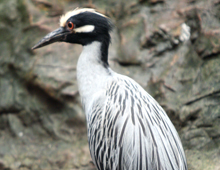Orinoco

Red-handed tamarin, Saguinus midas
Of the many kinds of small South American monkeys known as tamarins, most exhibit highly contrasting colors. This species is no exception. Most of its fur is dark, but its feet are bright orange. Another common name is Golden-handed tamarin, reflecting its scientific name, which commemorates King Midas and his mythical golden touch. This monkey is abundant in its Northeastern South American Range.
LEARN MORE
Boat-billed heron, Cochlearius cochlearius
Long thought to belong to a family all its own, this unique-looking, rather nocturnal bird has been reclassified as a member of the heron family. Dwelling in mangrove swamps from Mexico down to Peru and Brazil, it uses its strange beak to advantage, consuming a broad range of small animals. It thrives and breeds well in captivity, including the DWA.
LEARN MORE
Northern helmeted curassow, Pauxi pauxi
This bird was once extremely rare in captivity, but there are now more than 100 in collections around the world, almost all captive bred. This population is important as this species is endangered, with a wild population of less than 3,000 in the mountains of Colombia and Venezuela. Several have recently hatched at the DWA. The bizarre blue “helmet” is actually part of the skull.
LEARN MORE
Swainson’s toucan, Ramphastos swainsonii
While this bird is still considered fairly common, deforestation is reducing its habitat throughout its range, from Honduras to Ecuador. A particularly noisy toucan, its puppy-like yelps are heard all day in the DWA rainforest. This is another toucan targeted for breeding by the American Zoo community and nearly 40 are distributed among 20 participating collections. The DWA has been one of the few places to so far breed it in captivity.
LEARN MORE
Yellow-crowned night heron, Nyctanassa violacea
Specializing in crayfish, crabs, and other crustaceans, this small heron has gourmet tastes. Once considered a rather tropical bird, it has expanded its North American range in recent years to the north and west. It is also found throughout Central and South America. It has nested repeatedly in this exhibit, performing courtship displays and raising chicks.
LEARN MORE
Toco toucan, Ramphastos toco
Dwelling on the edges of forests, along rivers, and where trees are present in savannahs, this huge toucan is the only member of its family commonly found in open country. It inhabits an enormous range, all the way from the Guianas to Northern Argentina. It is the largest and best known of the toucan species and includes grunts in its vocalizations. Over 100 have been hatched in more than a dozen US collections (including the DWA), as part of a coordinated breeding program during the last quarter century.
LEARN MORE
Chiriqui quail-dove, Geotrygon chiriquensis
Like other quail-doves, Chirquis spend most of their time on the ground. This species is found in mountain forests in Panama and Costa Rica. Though a number were hatched in a California private collection in the 1950s, it had become very rare in captivity when two pairs from Panama were received by the DWA in 2008. Breeding commenced soon after arrival, and many have hatched since. They are displayed in several places in the facility.
LEARN MORE
Blue-crowned manakin, Lepidothrix coronata
Compared to some other manakins, the male Blue-crowned manakin performs a quieter display, bowing its brilliantly colored head forward while giving a musical trill. Despite having an extensive range, from Costa Rica and Panama, all the way south to Bolivia, it has always been rare in captivity
LEARN MORE
Lance-tailed manakin, Chiroxiphia lanceolata
Males of this species perform their display in teams of two, jumping up and down, side by side, on a branch, while snarling and whistling. Found in Costa Rica, Panama, Colombia, and Venezuela, it has never been common in captivity.
LEARN MORE
Golden-collared Manakin, Manacus vitellinus
Found in Panama and Colombia, this little bird has proved adaptable to disturbed habitats, flourishing in second-growth woods. The elongated feathers, arranged like a beard beneath the male’s throat, can be bunched together like a pointing finger, parallel with its beak. With those feathers thus positioned, the male performs its courtship display by darting suddenly from branch to branch while making startling snapping sounds with its wings. The only captive hatchings have taken place at the DWA, with twelve hatchings since the first in 2009.
LEARN MORE

